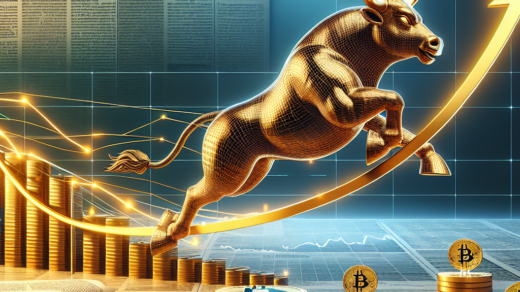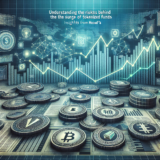How EU’s MiCA Regulations Will Propel Euro Denominated Stablecoins: Insights from JPMorgan
The European Union’s new Markets in Crypto-Assets (MiCA) regulations, which took effect on December 30, are set to transform the cryptocurrency landscape, particularly for euro-denominated stablecoins. According to a recent research report from JPMorgan Chase & Co., these regulations will likely provide a significant boost for compliant stablecoins like Circle’s EURC while creating hurdles for non-compliant options such as Tether’s EURT. In this article, we will explore the implications of MiCA, the evolving stablecoin market, and what this means for investors and traders in the crypto space.
Understanding MiCA Regulations: A Game Changer for Stablecoins
The MiCA regulations introduce a comprehensive framework designed to govern cryptocurrencies and stablecoins within the EU. This legislation mandates that only compliant stablecoins can be utilized as trading pairs in regulated markets, compelling EU exchanges to adapt their offerings accordingly. This shift is expected to reshape the competitive landscape in the stablecoin market, benefiting those who align with the new regulatory requirements.
As the crypto industry matures, regulations like MiCA are pivotal in establishing a secure environment for digital asset trading. This is particularly crucial given the increasing scrutiny from global financial authorities. By enforcing compliance, MiCA aims to protect investors and ensure the stability of the cryptocurrency market.
The Rise of Compliant Stablecoins: Circle’s EURC Takes Center Stage
JPMorgan analysts, led by Nikolaos Panigirtzoglou, highlighted that compliant stablecoins such as Circle’s EURC are poised to gain market strength under the new MiCA regulations. The emphasis on compliance means that stablecoin issuers must maintain substantial reserves in European banks and secure the necessary licenses for trading. This requirement not only enhances the credibility of compliant stablecoins but also instills confidence among investors.
Circle’s EURC, which is pegged to the euro, stands to benefit significantly as it meets these regulatory criteria. The growing demand for euro-denominated stablecoins is a reflection of the European market’s preference for stability and compliance, making EURC an attractive option for traders and investors.
Tether Faces Challenges: The Impact of MiCA on Non-Compliant Stablecoins
On the other hand, non-compliant stablecoins like Tether’s EURT are facing significant challenges due to the new regulations. JPMorgan noted that Tether has decided to discontinue its EURT stablecoin, resulting in the delisting of its USDT stablecoin from various EU exchanges. This strategic move underscores the difficulties non-compliant stablecoin issuers face as they navigate the evolving regulatory landscape.
Despite these setbacks, Tether remains a dominant player in the global stablecoin market, particularly in Asian markets where regulations may be less stringent. The company’s ability to maintain its market position, while adapting to new regulatory challenges, is a testament to its resilience and strategic foresight.
Tether’s Strategic Investments in Compliance
In an effort to remain relevant within the EU’s regulatory framework, Tether has made notable investments in MiCA-compliant stablecoin issuers, such as Quantoz Payments and StablR. These investments signal Tether’s commitment to maintaining a presence in the European market while adapting to the new compliance landscape.
By investing in companies that align with MiCA regulations, Tether is not only securing its future in the EU but also reinforcing its reputation as a key player in the global stablecoin market. This strategy reflects a broader trend among cryptocurrency companies to adapt and thrive in an increasingly regulated environment.
What This Means for Investors and Traders
The implementation of MiCA regulations presents both challenges and opportunities for investors and traders in the cryptocurrency market. For those looking to invest in euro-denominated stablecoins, compliant options like Circle’s EURC offer a safer avenue, backed by regulatory support and market confidence.
Conversely, non-compliant stablecoins may experience increased volatility and reduced liquidity as exchanges adjust their offerings to meet regulatory standards. Investors should be mindful of these dynamics when considering their stablecoin investments.
The Future of Stablecoins in Europe
As the EU continues to refine its regulatory framework for cryptocurrencies, the landscape for stablecoins is poised for significant change. The MiCA regulations are just the beginning of a broader movement towards greater transparency and compliance in the crypto market. For investors, understanding these regulations and their implications will be essential for navigating the evolving landscape.
With the rise of compliant stablecoins, we may see a shift in the balance of power within the stablecoin market. Traditional financial institutions and regulatory bodies are increasingly recognizing the importance of stablecoins as a bridge between fiat and digital assets, further solidifying their role in the financial ecosystem.
Conclusion: A New Era for Stablecoins Awaits
The implementation of the EU’s MiCA regulations marks a pivotal moment for the cryptocurrency market, particularly for euro-denominated stablecoins. With compliant options like Circle’s EURC gaining traction, and non-compliant alternatives like Tether’s EURT facing challenges, the landscape is set for transformation.
As the market adapts to these changes, investors and traders must remain vigilant and informed. Understanding the implications of evolving regulations and the dynamics within the stablecoin market will be crucial for making strategic investment decisions.
For those interested in diving deeper into the world of cryptocurrencies, you can explore our guides on How to Buy Bitcoin, How to Buy Cryptocurrency, and What is XRP.
As we move forward into this new era of cryptocurrency, the focus on compliance and regulation will only grow, shaping the future of digital assets in Europe and beyond.











